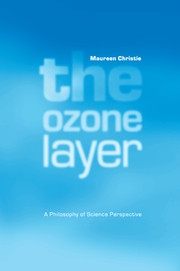Book contents
- Frontmatter
- Contents
- List of figures
- List of abbreviations
- Preface
- 1 Introduction
- Part I History of the understanding of stratospheric ozone
- Part II Philosophical issues arising from the history
- 9 Prediction in science
- 10 The crucial experiment
- 11 Positive and negative evidence in theory selection
- 12 Branches and sub-branches of science: problems at disciplinary boundaries
- 13 Scientific evidence and powerful computers: new problems for philosophers of science?
- 14 The scientific consensus
- References
- Index
9 - Prediction in science
Published online by Cambridge University Press: 22 September 2009
- Frontmatter
- Contents
- List of figures
- List of abbreviations
- Preface
- 1 Introduction
- Part I History of the understanding of stratospheric ozone
- Part II Philosophical issues arising from the history
- 9 Prediction in science
- 10 The crucial experiment
- 11 Positive and negative evidence in theory selection
- 12 Branches and sub-branches of science: problems at disciplinary boundaries
- 13 Scientific evidence and powerful computers: new problems for philosophers of science?
- 14 The scientific consensus
- References
- Index
Summary
The 1995 Nobel Prize in Chemistry was awarded to Sherwood Rowland and Mario Molina, and to Paul Crutzen. The basis of the award to Rowland and Molina was their work of 1973–6, where they first called attention to the importance of chlorine compounds in stratospheric chemistry, and investigated the possible effects of anthropogenic chlorine-containing compounds on the stratospheric ozone layer. Crutzen's earlier work (1968–73) involved the chemistry of trace substances crossing from the upper troposphere to the lower stratosphere, and investigation of the effects of water vapour and oxides of nitrogen on the ozone layer. For all three scientists there had, of course, been a continuing involvement in the investigation of stratospheric chemistry from that time onward. The particular focus of this chapter is on the early work of Molina and Rowland.
The award of a Nobel Prize, while arguably influenced by significant political factors, is a clear mark of recognition and great respect by a scientific peer group for the piece of scientific work involved. In this case, there is ample additional evidence that Molina and Rowland's work is very highly regarded in the community of atmospheric scientists.
An important aspect of Molina and Rowland's early work is that their initial scientific findings led them to publish material which incorporated predictions – predictions with both scientific and public policy implications. Several philosophers of science have written about the part that prediction plays in the practice of science and the gaining of scientific knowledge.
- Type
- Chapter
- Information
- The Ozone LayerA Philosophy of Science Perspective, pp. 73 - 92Publisher: Cambridge University PressPrint publication year: 2001



